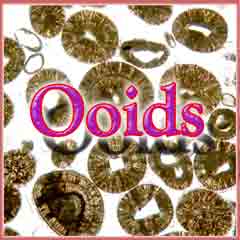 Ooids Ooids
Coated grains include oolites, pisolites, oncoids, and oncolites. oolites (figure below) are formed by a series of concentric layers surrounding a nucleus.
Most recent ooids from modern marine settings like the Bahama Banks exhibit concentric coatings that have an organized microstructure of tangentially arranged aragonite needles. However, some recent ooids from the Great Salt Lake of Utah and the Persian Gulf in the vicinity of Qatar have a radial fabric of needles. A similar fabric is common to most ancient ooids. The size of ooids is controlled by rate of precipitation and abrasion. Ooid grains generally range between .5 and 1mm in diameter. Ooids with asymmetric coatings and superficial oolites form in quiet water. Occasionally broken radial ooids may act as the nuclei for other ooids suggesting that the radial fabric is developed during deposition. Breakage is common in oolites that collect on salt flats where halite precipitation has weakened the radial fabric.
|